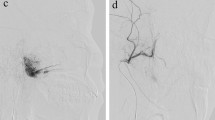Abstract
Purpose
To determine the effects of blood supply from internal carotid artery (ICA) on the surgical outcomes of primary juvenile nasopharyngeal angiofibroma (JNA) after transarterial embolization (TAE).
Methods
A retrospective analysis was performed on primary JNA patients who underwent TAE and endoscopic resection in our hospital between December 2020 and June 2022. The angiography images of these patients were reviewed, and then they were divided into ICA + external carotid artery (ECA) feeding group and ECA feeding group according to whether the ICA branches were part of the feeding arteries. Tumors in ICA + ECA feeding group were fed by both ICA and ECA branches, while tumors in ECA feeding group were fed by ECA branches alone. All patients underwent tumor resection immediately after ECA feeding branches embolization. None of the patients underwent ICA feeding branches embolization. Data on demographics, tumor characteristics, blood loss, adverse events, residual and recurrence were collected, and case–control analysis was performed for the two groups. Differences in characteristics between the groups were tested using Fisher’s exact and Wilcoxon tests.
Results
Eighteen patients were included in this study: nine in ICA + ECA feeding group and nine in ECA feeding group. The median blood loss was 700 mL (IQR 550–1000 mL) in ICA + ECA feeding group versus 300 mL (IQR 200–1000 mL) in ECA feeding group, with no significant statistical difference (P = 0.306). Residual tumor was found in one patient (11.1%) in both groups. Recurrence was not observed in any patient. There were no adverse events from embolization and resection in either group.
Conclusion
The results of this small series suggest that the presence of blood supply from ICA branches in primary JNA has no significant effect on intraoperative blood loss, adverse event, residual and postoperative recurrence. Therefore, we do not recommend routine preoperative embolization of ICA branches.
Level of Evidence
Level 4, Case–control.
Graphical Abstract






Similar content being viewed by others
References
Mehan R, Rupa V, Lukka VK, Ahmed M, Moses V, Shyam Kumar NK. Association between vascular supply, stage and tumour size of juvenile nasopharyngeal angiofibroma. Eur Arch Otorhinolaryngol. 2016;273(12):4295–303.
Leong SC. A systematic review of surgical outcomes for advanced juvenile nasopharyngeal angiofibroma with intracranial involvement. Laryngoscope. 2013;123(5):1125–31.
Giorgianni A, Molinaro S, Agosti E, et al. Twenty years of experience in juvenile nasopharyngeal angiofibroma (JNA) preoperative endovascular embolization: an effective procedure with a low complications rate. J Clin Med. 2021;10(17):3926.
Song X, Wang D, Sun X, et al. Cumulative sum analysis of the learning curve for endoscopic resection of juvenile nasopharyngeal angiofibroma. Surg Endosc. 2018;32(7):3181–91.
Snyderman CH, Pant H, Carrau RL, Gardner P. A new endoscopic staging system for angiofibromas. Arch Otolaryngol Head Neck Surg. 2010;136(6):588–94.
Bignami M, Pietrobon G, Arosio AD, et al. Juvenile angiofibroma: what is on stage? Laryngoscope. 2022;132(6):1160–5.
Gargula S, Saint-Maurice JP, Labeyrie MA, et al. Embolization of internal carotid artery branches in juvenile nasopharyngeal angiofibroma. Laryngoscope. 2021;131(3):E775–80.
Radkowski D, McGill T, Healy GB, Ohlms L, Jones DT. Angiofibroma. Changes in staging and treatment. Arch Otolaryngol Head Neck Surg. 1996;122(2):122–9.
Diaz A, Wang E, Bujnowski D, et al. Embolization in juvenile nasopharyngeal angiofibroma surgery: a systematic review and meta-analysis. Laryngoscope. 2023. https://doi.org/10.1002/lary.30616.
Kothari DS, Linker LA, Tham T, et al. Preoperative embolization techniques in the treatment of juvenile nasopharyngeal angiofibroma: a systematic review. Otolaryngol Head Neck Surg. 2023. https://doi.org/10.1002/ohn.303.
Abdelwahab M, Overdevest JB, Elmokadem A, et al. Nasopharyngeal angiofibroma staging with a novel nominal basis: an 18-year study in a tertiary center. Otolaryngol Head Neck Surg. 2019;161(2):352–61.
Wang M, Fan W, Mungur R, Gu J, Wan S. Endovascular treatment of congenital internal carotid-jugular fistula. Front Neurol. 2018;9:1118.
Adachi K, Hayakawa M, Sadato A, et al. Modified balloon protection technique for preoperative embolization of feeder arteries from internal carotid artery branches to skull-base tumor: technical note. J Neurol Surg A Cent Eur Neurosurg. 2016;77:161–6.
Yoon N, Shah A, Couldwell WT, Kalani MYS, Park MS. Preoperative embolization of skull base meningiomas: current indications, techniques, and pearls for complication avoidance. Neurosurg Focus. 2018;44:E5.
Robinson DH, Song JK, Eskridge JM. Embolization of meningohypophyseal and inferolateral branches of the cavernous internal carotid artery. AJNR Am J Neuroradiol. 1999;20:1061–7.
Halbach VV, Higashida RT, Hieshima GB, Hardin CW. Embolization of branches arising from the cavernous portion of the internal carotid artery. AJNR Am J Neuroradiol. 1989;10:143–50.
Funding
This study was not supported by any funding.
Author information
Authors and Affiliations
Corresponding author
Ethics declarations
Conflict of interest
The authors declare that they have no conflict of interest.
Consent for Publication
Consent for publication was obtained for every individual person’s data included in the study.
Ethical Approval
For this type of study formal consent is not required.
Informed Consent
Informed consent was obtained from all individual participants included in the study.
Additional information
Publisher's Note
Springer Nature remains neutral with regard to jurisdictional claims in published maps and institutional affiliations.
Rights and permissions
Springer Nature or its licensor (e.g. a society or other partner) holds exclusive rights to this article under a publishing agreement with the author(s) or other rightsholder(s); author self-archiving of the accepted manuscript version of this article is solely governed by the terms of such publishing agreement and applicable law.
About this article
Cite this article
Liu, Q., Xia, Z., Hong, R. et al. Preoperative Embolization of Primary Juvenile Nasopharyngeal Angiofibroma: Is Embolization of Internal Carotid Artery Branches Necessary?. Cardiovasc Intervent Radiol 46, 1038–1045 (2023). https://doi.org/10.1007/s00270-023-03483-1
Received:
Accepted:
Published:
Issue Date:
DOI: https://doi.org/10.1007/s00270-023-03483-1




